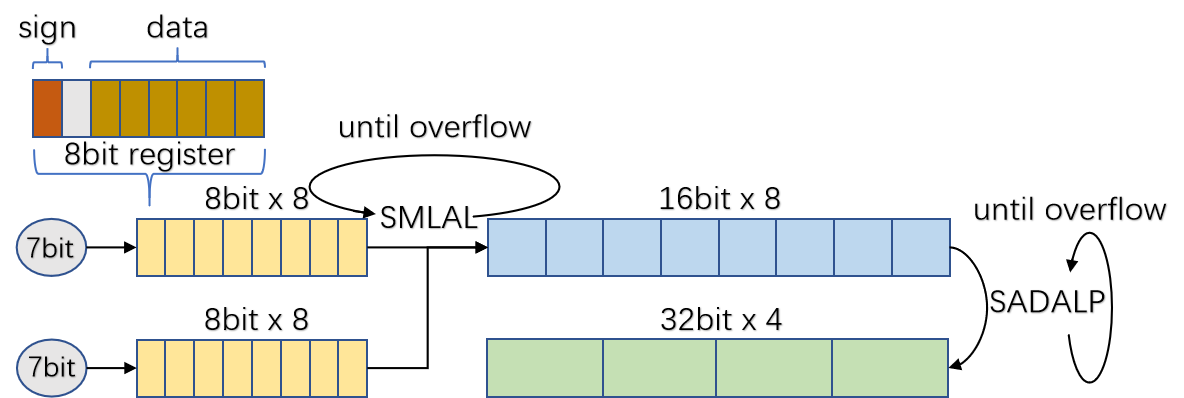EasyQuant(EQ) is an efficient and simple post-training quantization method via effectively optimizing the scales of weights and activations. Our paper is available on arXiv
pip install -r requirements.txt
- 06/25/2020: We have released EasyQuant.pdf paper and eq-ncnn.
- 06/24/2020: We have released VGG16 example.
First, for ImageNet1k classification task, please download ImageNet2012. We random sampled 3000 calibration images from ImageNet val set to data/calib.txt for KLD quantization and select 50 samples from calib to data/list50.txt for EasyQuant scale finetuning. Then we will evaluate quantified models on val set.
- Get caffe and ncnn ready
- Build python_ncnn
#
cd python_ncnn
# modify ncnn build path in Makefile
make -j8
- Run VGG16 example
cd ..
sh example/vgg16/run.sh
This following 6 steps will be performed in run.sh.
# download vgg16 model and upgrade proto and caffemodel files
sh model/vgg16/net_file_upgrade.sh
# generate scale of weight and activation use quantation tools
sh example/vgg16/run_scale_quantation.sh
# get ncnn param bin from scale table
sh example/vgg16/run_caffe2ncnn.sh
# infer layer blob shape
sh example/vgg16/run_infer_shape.sh
# run scale fine tuning
sh example/vgg16/run_scale_fine_tuning.sh
# run validtion on imagenet val
sh example/vgg16/run_validation.sh
1. Classification on ImageNet2012 validation dataset for different convolutional models in context of both INT8 and INT7 post-training quantization.
| Models | FP32 | INT8-TRT | INT8-EQ | INT7-TRT | INT7-EQ |
|---|---|---|---|---|---|
| SqueezeNetV1.1 | 56.56 | 56.24 | 56.28 | 54.88 | 56.08 |
| MobileNetV1 | 69.33 | 68.74 | 68.84 | 66.97 | 68.26 |
| VGG16 | 70.97 | 70.95 | 70.97 | 70.92 | 70.96 |
| ResNet50 | 75.20 | 75.04 | 75.13 | 72.78 | 75.04 |
| Models | FP32 | INT8-TRT | INT8-EQ | INT7-TRT | INT7-EQ |
|---|---|---|---|---|---|
| SqueezeNet-SSD | 62.00 | 61.45 | 62.05 | 60.01 | 61.62 |
| MobileNet-SSD | 72.04 | 69.79 | 71.39 | 63.88 | 68.79 |
| Models | FP32 | INT8-TRT | INT8-EQ | INT7-TRT | INT7-EQ |
|---|---|---|---|---|---|
| lfw | 99.45 | 99.36 | 99.48 | 99.28 | 99.36 |
| agedb_30 | 95.78 | 95.23 | 95.38 | 95.03 | 95.73 |
| calfw | 95.05 | 94.76 | 94.88 | 94.75 | 94.68 |
| cfp_ff | 99.50 | 99.50 | 99.61 | 99.44 | 99.60 |
| cfp_fp | 89.77 | 89.17 | 90.04 | 88.47 | 89.87 |
| cplfw | 86.45 | 85.58 | 86.03 | 85.91 | 86.76 |
| vgg2_fp | 90.64 | 89.70 | 90.50 | 89.64 | 90.44 |
| Methods | MobileNetV1-FP32 | MobileNetV1-INT8 | ResNet50-FP32 | ResNet50-INT8 |
|---|---|---|---|---|
| EQ | 69.33 | 68.84 | 75.20 | 75.13 |
| QAT | 70.90 | 70.70 | 75.20 | 75.00 |
INT7 Post-training Inference VS INT8 on real devices.
We implement our efficient designs on INT7 post-training inference which well be released in eq-ncnn

1. The latency (ms) performance on RK3399, whose inside is a 1.5 GHz 64-bit Quad-core ARM Cortex-A53. #k means k threads.
| Models | TRT-INT8(#1) | EQ-INT7(#1) | TRT-INT8(#4) | EQ-INT7(#4) |
|---|---|---|---|---|
| SqueezeNetV1.1 | 180 | 120 | 66 | 44 |
| MobileNetV1 | 234 | 189 | 65 | 57 |
| VGG16 | 3326 | 2873 | 1423 | 1252 |
| ResNet50 | 1264 | 993 | 415 | 300 |
2. The latency (ms) performance on RK3399, which inside is a 1.8 GHz 64-bit Dual-core ARM Cortex-A72. #k means k threads.
| Models | TRT-INT8(#1) | EQ-INT7(#1) | TRT-INT8(#2) | EQ-INT7(#2) |
|---|---|---|---|---|
| SqueezeNetV1.1 | 79 | 57 | 54 | 37 |
| MobileNetV1 | 105 | 84 | 56 | 46 |
| VGG16 | 1659 | 1385 | 1034 | 849 |
| ResNet50 | 559 | 463 | 338 | 262 |
PRs accepted.
BSD3 © DeepGlint
@inproceedings{easyquant,
title={EasyQuant: Post-training Quantization via Scale Optimization},
author={Di Wu, Qi Tang, Yongle Zhao, Ming Zhang, Debing Zhang, Ying Fu},
year={2020}
}